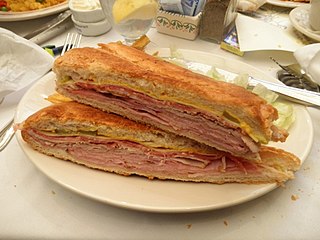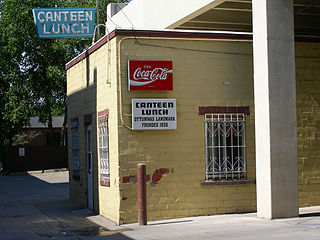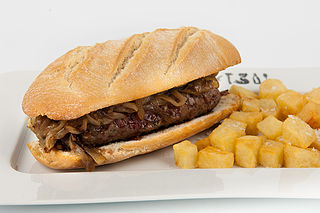
Midwestern cuisine is a regional cuisine of the American Midwest. It draws its culinary roots most significantly from the cuisines of Central, Northern and Eastern Europe, and Indigenous cuisine of the Americas, and is influenced by regionally and locally grown foodstuffs and cultural diversity.

New England cuisine is an American cuisine which originated in the New England region of the United States, and traces its roots to traditional English cuisine and Native American cuisine of the Abenaki, Narragansett, Niantic, Wabanaki, Wampanoag, and other native peoples. It also includes influences from Irish, French, Italian, and Portuguese cuisine, among others. It is characterized by extensive use of potatoes, beans, dairy products and seafood, resulting from its historical reliance on its seaports and fishing industry. Corn, the major crop historically grown by Native American tribes in New England, continues to be grown in all New England states, primarily as sweet corn although flint corn is grown as well. It is traditionally used in hasty puddings, cornbreads and corn chowders.

A hamburger, or simply burger, is a sandwich consisting of fillings—usually a patty of ground meat, typically beef—placed inside a sliced bun or bread roll. Hamburgers are often served with cheese, lettuce, tomato, onion, pickles, bacon, or chilis; condiments such as ketchup, mustard, mayonnaise, relish, or a "special sauce", often a variation of Thousand Island dressing; and are frequently placed on sesame seed buns. A hamburger patty topped with cheese is called a cheeseburger.

English cuisine encompasses the cooking styles, traditions and recipes associated with England. It has distinctive attributes of its own, but is also very similar to wider British cuisine, partly historically and partly due to the import of ingredients and ideas from the Americas, China, and India during the time of the British Empire and as a result of post-war immigration.

A sandwich is a food typically consisting of vegetables, sliced cheese or meat, placed on or between slices of bread, or more generally any dish wherein bread serves as a container or wrapper for another food type. The sandwich began as a portable, convenient finger food in the Western world, though over time it has become prevalent worldwide.

The Reuben sandwich is a North American grilled sandwich composed of corned beef, Swiss cheese, sauerkraut, and Thousand Island dressing or Russian dressing, grilled between slices of rye bread. It is associated with kosher-style delicatessens, but is not kosher because it combines meat and cheese.

A Cuban sandwich is a variation of a ham and cheese sandwich that likely originated in cafes catering to Cuban workers in Tampa or Key West, two early Cuban immigrant communities in Florida centered on the cigar industry. Later on, Cuban exiles and expatriates brought it to Miami, where it is also very popular. The sandwich is made with ham, (mojo) roasted pork, Swiss cheese, pickles, mustard, and sometimes salami on Cuban bread. Salami is included in Tampa, where there is a large Italian population, but is not usually included in South Florida.

Cuban cuisine is largely based on Spanish cuisine with influence from African and other Caribbean cuisines. Some Cuban recipes share spices and techniques with Spanish, African and Taino cooking, with some Caribbean influence in spice and flavor. This results in a blend of several different cultural influences. A small but noteworthy Chinese influence can also be accounted for, mainly in the Havana area. There is also some Italian influence. During colonial times, Cuba was an important port for trade, and the Spanish ancestors of Cubans brought with them the culinary traditions of different parts of Spain.

The cuisine of New York City comprises many cuisines belonging to various ethnic groups that have entered the United States through the city. Almost all ethnic cuisines are well represented in New York, both within and outside the various ethnic neighborhoods.

A sloppy joe is a sandwich consisting of ground beef, onions, tomato sauce or ketchup, Worcestershire sauce, and other seasonings, served on a hamburger bun. There are several theories about the sandwich's origin.

A tavern sandwich is a sandwich consisting of ground beef on a bun, mixed with sauteed onions, and sometimes topped with pickles, ketchup, mustard, and cheese.

The cuisine of Philadelphia was shaped largely by the city's mixture of ethnicities, available foodstuffs and history. Certain foods have become associated with the city.

Kosher style refers to foods commonly associated with Jewish cuisine but which may or may not actually be kosher. It is a stylistic designation rather than one based on the laws of kashrut. Generally, kosher-style food does not include meat from forbidden animals, such as pigs and shellfish, and does not contain both meat and milk in the same dish; however if such dish includes meat, it may not be kosher slaughtered. In some U.S. states, the use of this term in advertising is illegal as a misleading term under consumer protection laws.

Canteen Lunch in the Alley is a restaurant located in Ottumwa, Iowa. The original five-stool Canteen Lunch was opened in 1927 in a different location, and moved to its current address in 1936. It has since been a local institution known for their loose-meat sandwiches and homemade pies. The restaurant's design is a horseshoe-shaped counter-top surrounded by 16 stools. The “Canteen Lunch” was originally established in 1927. In 1936, the business relocated to its present location under the second street parking ramp in Ottumwa, Iowa. It remains an outstanding example of an early to mid-20th century lunchroom. The “Canteen Lunch” reflects on this type of eating establishment that gained popularity in the 1920s and 1930s as social and economic challenges were felt by the Great Depression.

A steak sandwich is a sandwich prepared with steak that has been broiled, fried, grilled, barbecued or seared using steel grates or gridirons, then served on bread or a roll. Steak sandwiches are sometimes served with toppings of cheese, onions, mushrooms, peppers, tomatoes, and in some instances fried eggs, coleslaw, and french fries.

Carnation Cafe is an American comfort food restaurant located in Main Street, U.S.A. at Disneyland in Anaheim, California in the United States. The restaurant opened in 1955 as Carnation Cafe Ice Cream Parlor.

The Cuisine of Ohio is part of the broader regional cuisine of the Midwestern United States.

The pepito is a sandwich prepared with beef, pork, or chicken originating from Spain and also very popular in Latin America. It is a common street food in Venezuela and is also available at some U.S. restaurants. For the beef version, various cuts of beef are used, and myriad additional ingredients can also be used in its preparation.

American Jewish cuisine comprises the food, cooking, and dining customs associated with American Jews. It was heavily influenced by the cuisine of Jewish immigrants who came to the United States from Eastern Europe around the turn of the 20th century. It was further developed in unique ways by the immigrants and their descendants, especially in New York City and other large metropolitan areas of the northeastern U.S.
















